26 Mar 03/26/2021
Shining a Light on Ladder Safety
Ladders are essential tools for workers in every industry that MCR Safety helps protect from injuries, from automotive and construction to metal fabrication, mining, and more. Ladders are a handy tool outside of work, too. Most homeowners have at least one ladder on hand and use it to tackle household chores like changing ceiling light bulbs or repairing hard-to-reach areas of a home, both inside and out.
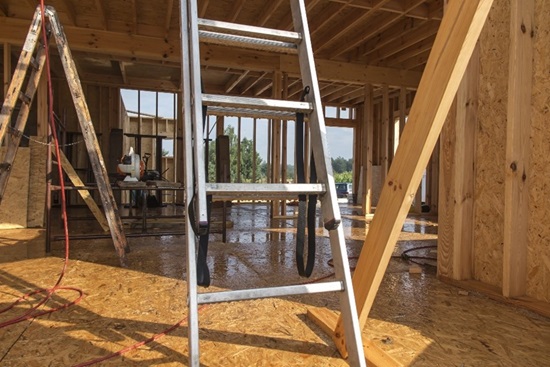
Ladders are a crucial component of any construction worksite. Whether it's framing, roofing, or painting, all construction workers require ladders to perform their job.
Ladders are one of the most beneficial tools a worker will ever use. However, like all tools, proper safety measures must be taken when using a ladder; otherwise, one could put themselves in danger of falling and potentially suffering from a lifelong injury. Here are some jaw-dropping stats that should make you consider the importance of ladder safety:
- Each year in the U.S., more than 164,000 emergency room-treated injuries and 300 deaths are caused by falls off ladders.
- 100+ ladder injuries occur every day.
- $17.1 billion is spent on workplace falls related to ladders.
- Most ladder injuries occur due to missing the last step.
This article is designed to provide an overview of ladder types and load ratings, proper selection, and correct usage to help keep you safe.
Types of Ladders

Ladders are made from different types of materials such as fiberglass, metal, and wood. They are manufactured in various shapes and sizes to accommodate an environment's physical size restrictions and its work. Here is a summary of the different ladder types you will find in use:
- Articulated Ladder – These hinging ladders can change to fit the job. Articulated ladders have one or more locking hinges to keep them in place and allow them to be set up in numerous shapes and configurations.
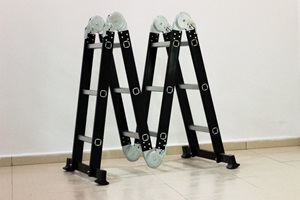
Articulated
- Extension Ladder – As the name suggests, these ladders have sliding sections that allow the ladder to extend to greater heights. An extension ladder is not self-supporting, which means you need to lean it against something to keep it secure.
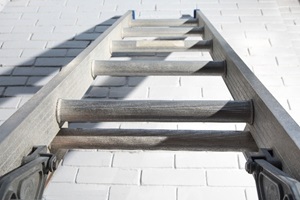
Extension
- Flexible or Rope Ladder – Easy to store or pull out of the way, these ladders have rungs that are generally shorter pieces connected to two long pieces of rope.
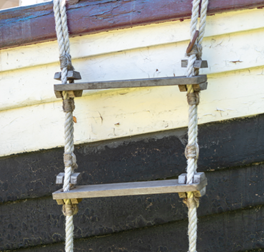
Rope
- Multipurpose or Trestle Ladder –The trestle ladder is self-supporting, non-adjustable, and is hinged at the top. It is known for having greater versatility compared to other ladders.
- Platform Ladder – Although also non-adjustable, these ladders feature a platform for standing on at the top level. A platform ladder is excellent when working in an area for an extended amount of time.
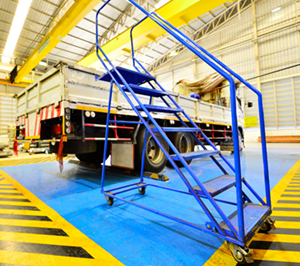
Platform
- Step Ladder – One of the most popular ladder types due to its versatility, step ladders feature wide flat steps, two legs connected by a hinge at the top, and a small platform. They are self-supporting, so you can take these ladders wherever you need them.
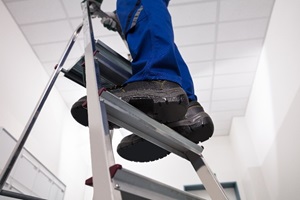
Step Ladder
- Step Stool – Similar to the step ladder, step stools are generally more compact versions, providing a low rung of hinged steps to offer extra reach. These ladders offer convenience, are self-supporting, and are handy to have around.

Step Stool
- Tripod Ladder – Commonly used in agricultural harvesting, tripod ladders are portable, stable, and self-supporting.
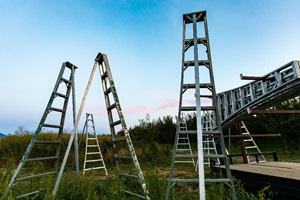
Tripod
- Telescoping Ladder – More portable than an extension ladder, telescoping ladders slide down to "telescope" or stack down onto the next lowest rung.
One crucial but often overlooked aspect of ladder safety is ensuring that the ladder's correct length be used for the job. Overreaching is one of the most common ways people fall from a ladder – they need something just a little longer or one that can fit a little closer to the task. If you have to step on the top rung of a step ladder to reach something, you should choose a different size ladder.
Load Ratings

Similar to how personal protective equipment (PPE) features performance ratings, the American National Standards Institute (ANSI) oversees requirements for the construction, design, and labeling of ladders. The overarching standard for ladders is ANSI ASC A14. Underneath this standard is the sub-standards that focus on specific ladder materials.
Here are some of the different ladder sub-standards:
- ANSI-ASC A14.1-2017 – portable wood ladders
- ANSI ASC A14.2-2017 - portable metal ladders
- ANSI-ASC A14.5-2017 – portable reinforced plastic
- ANSI-ASC A14.7-2011 – mobile ladder stands and platforms
- ANSI-ASC A14.11-2018 - stepstools
ANSI's load ratings are set based on the amount of weight that can be safely held on a ladder. This maximum weight number is called the load capacity, and it represents the person's combined weight and whatever tools or equipment the climber is carrying when on the ladder. ANSI's five load ratings are as follows:
| Duty Rating | Use | Load (in pounds) | |
|---|---|---|---|
| Type IAA | Special | Rugged | 375 |
| Type IA | Extra | Industrial | 300 |
| Type I | Heavy | Industrial | 250 |
| Type II | Medium | Commercial | 225 |
| Type III | Light Duty | Household | 200 |
Type II and Type III ladders should not be used in construction or general industry settings.
Falls and Injuries
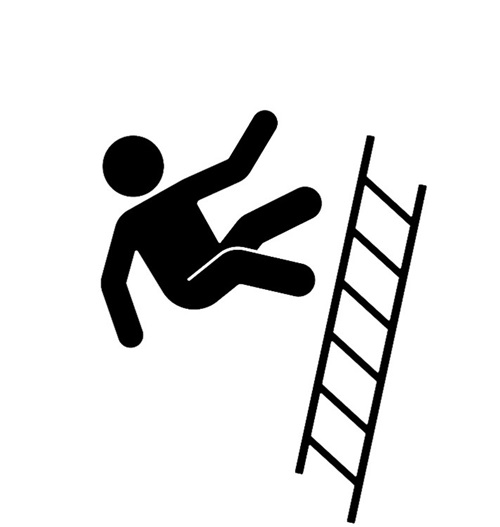
Gravity will win any time someone loses grip of their ladder, and, unfortunately, gravity is winning a lot across industries. According to the Centers for Disease Control and Prevention (CDC), 43% of fatal falls nationwide involve a ladder. High falls account for almost 700 occupational deaths in any given year, representing 15% of all occupational deaths.
The CDC also reports that 20% of fall injuries across all types of workers involve a ladder. Whether someone doesn't set up the ladder correctly, missteps while climbing or descending a ladder, loses their balance or overreaches while on the ladder, most deaths are from falls of 10 feet or less.
OSHA Guidance
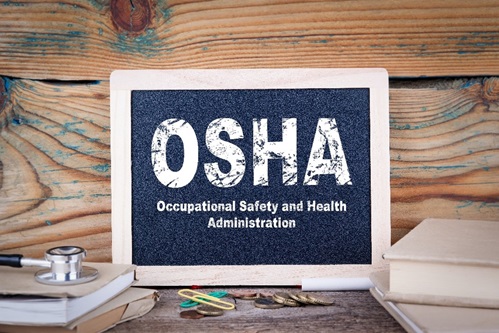
The Occupational Safety Health Administration (OSHA) provides ladder regulations for all industries to follow. OSHA Subpart D 1910.23 is the specific standard that addresses ladder safety across all general sectors and covers the minimum national requirements companies must follow when using ladders. The standard's four main components are general requirements, portable ladders, fixed ladders, and mobile ladders. Here are some of the overall general requirements listed within the standard:
- Employees must face the ladder when ascending or descending.
- Ladders must be carefully inspected before use.
- Ladders cannot be extended while in use.
- Ladders cannot be placed on boxes or barrels.
Thankfully, OSHA doesn't merely issue regulations without providing guidance. Their document on portable ladder safety offers numerous tips. Here are some:
- Maintain a 3-point contact while ascending or descending. This means two hands and a foot, or two feet and a hand are always on the ladder.
- Slippery material found anywhere on the ladder's steps, user's feet or placement location is absolutely no good.
- Only use a ladder when it's secured on stable ground.
- Never exceed the load ratings of the ladder.
- Choose the appropriate type and height of ladder for the job.
These are only a handful of the tips OSHA offers. Be sure to read their entire quick card for more safety measures. And for those who are looking for even more helpful information, consider these links:
- OSHA Stairways and Ladders
- Scaffold and Ladder Safety TrainingMobile Ladder Stands
- Protecting Workers in Agriculture
- Agriculture and Tripod Orchard Ladder Fact Sheet
- OSHA Bilingual PDF on Using Ladders Safely
Ladder Safety in Construction
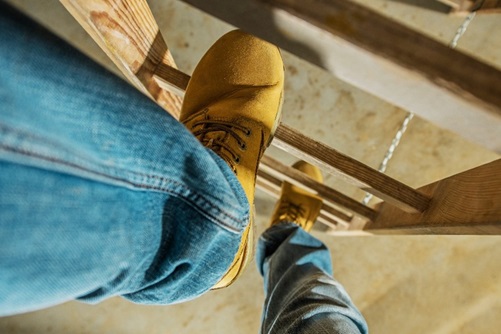
Ladders are one of the standard pieces of equipment found on virtually every construction site. This versatile tool can be erected in seconds, and it allows workers to quickly access higher levels. Unfortunately, the dangers we've covered throughout this article apply significantly to the construction industry.
Compared to all other industries, construction has the most ladder fall injuries (LFI). According to the CDC, 81% of all fall injuries reported in the construction industry involve a ladder. And, when a worker does fall, 25% of the time, that worker dies. Construction and extraction workers are the specific occupations that make up most LFIs in the construction industry.
What is even more shocking than the above injury statistics is the fact that, despite the dangers, proper ladder use in construction is rarely found. OSHA's third most cited violation for the construction industry is the improper use of ladders.
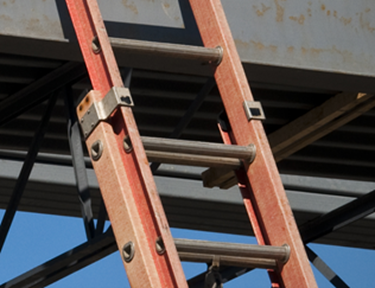
Improper ladder use is the 3rd most cited violation.
Fortunately, OSHA goes to great lengths to ensure this specific industry is well-informed on ladder use and ladder safety. OSHA's Construction eTool on Falls and Ladder Safety outlines particular OSHA requirements for ladder safety. The website addresses angles, rungs, and slipping hazards. Also, there is a published fact sheet geared toward reducing falls in construction. This easy-to-navigate document covers specifics around properly securing extension ladders and provides numerous safety tips construction workers should consider.
Proper Training

Ladder training is at the heart of minimizing ladder accidents, as injuries sustained by ladder falls are often the result of improper use. And of those injuries that do occur, most are due to lack of ladder education and not following proper safety guidelines. Workers must be able to recognize ladder hazards and minimize their existence to stay safe on the job.
Luckily, there are plenty of online training resources available for those who need proper ladder training. One reliable resource is the American Ladder Institute's Ladder Safety Training Videos page. There you will find free videos on ladder safety training for articulated ladders, extension ladders, mobile ladders, and step ladders.
There are also courses where official completion certifications are available. The one-hour OSHA Ladder Safety Course is an example of a 24/7 accessible online training session designed to teach construction workers many aspects of ladder safety. Some of these include selecting the proper ladder, using a ladder, adequate maintenance, and how to inspect a ladder for damage. Students will also learn about the expected hazards of operating a ladder.
In addition to training resources, the CDC and the National Institute for Occupational Safety and Health (NIOSH) have developed an innovative mobile application designed to improve extension and step ladder safety. The Ladder Safety App features a multi-modal indicator and visual guide for ladder selection, inspection, positioning, accessorizing, and safe use. Workers can now take advantage of 21st-century technology to address ladder safety.
Common Questions

At what height should safety devices be used on fixed metal ladders based on OSHA regulations?
- OSHA 1926.1053(a)(18) addresses this question. Safety devices are required when the climb's length is less than 24 feet, but the ladder is at a greater distance than 24 feet above lower levels.
How to tie off a ladder for safety?
- According to the Canadian Centre of Occupational Health and Safety, erect ladders should be set at least 3 feet above a landing platform. Then, the top ladder needs to be tied to support points. When a structure isn't available, you will need to use ladder hooks, or a similar component to secure the ladder. The ladder should also be tied at the base. When no structure is available at the bottom, one should tie the ladder to a stake in the ground. For more information about how to secure a ladder, be sure to read the OSHA construction PDF for securing a ladder.
What safety labels are on ladders?
- OSHA doesn't require instruction or warning signs to be placed on ladders. However, most ladder manufactures will add information on the proper use of their product. Without a formal standard in place, though, there isn't a consistent label found on all ladders.
How to inspect ladders?
- There are plenty of ladder inspection checklists available online. This PDF from Batavia Services highlights all areas that need to be inspected on a ladder from time to time. Here is one more inspection form to consider using.
Protecting People with Educational Information
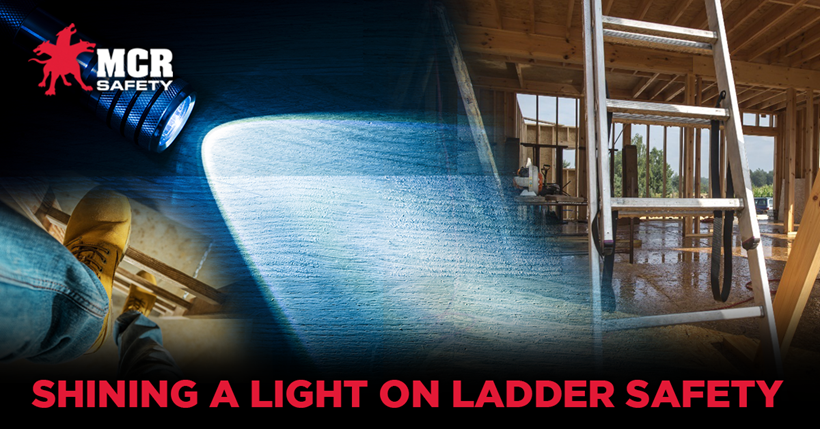
Ladder falls are not inevitable. OSHA believes that 100% of ladder accidents can be avoided with proper safety training on using the correct type of ladder, securing it properly, using it correctly, and avoiding worn or damaged ladders. Adequate safety training also can help ensure that anyone who gets on a ladder knows precisely what they should and should not be doing.
MCR Safety Construction Industry Resource Page
When it comes to preventing injuries on the worksite, MCR Safety is the expert in providing the appropriate PPE to keep you safe. If you're a construction professional, we encourage you to check out our dedicated Construction industry page, covering hazards and recommended PPE across ten individual construction subsector pages.
We welcome any comments, feedback, or suggestions for how we can best protect people at work.
For over 45 years, MCR Safety has proven to be a world leader in gloves, glasses, and garments. Whether it's on the shop floor, an oil rig, or a construction site, we are there to provide solutions to workplace hazards. It's all part of our commitment to protect people.
No matter your industry, we have the personal protective equipment you need.

Learn more about MCR Safety by checking out our most recent video. For more information, browse our website, request a catalog, find a distributor, or give us a call at 800-955-6887.
About the Author
Related Articles

Understanding ANSI Z87.1
ANSI/ISEA Z87.1-2020, the sixth revision of the voluntary eye and face protection standard,...
The Importance and Significance of ANSI Standards
The ANSI standards drive the decision-making and development of all personal protective equipment...
CDC and Its Role in Protecting Americans’ Health
When it comes to issues affecting Americans' health and safety, people turn to the guidance...Latest Articles







